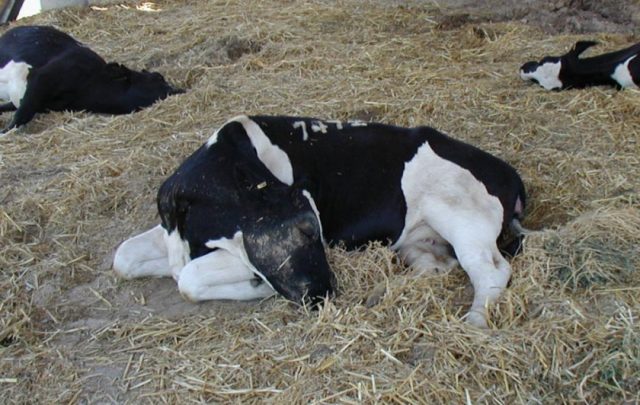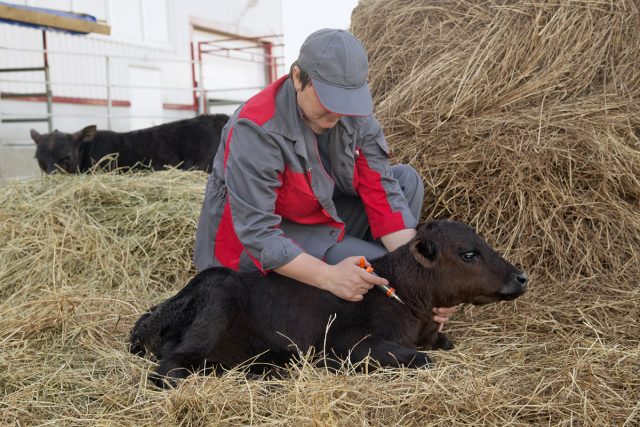Content
Schmallenberg disease in cattle was first registered not so long ago, only in 2011. Since then, the disease has become widespread, spreading beyond the place of registration - a farm in Germany, near Cologne, where the virus was diagnosed in dairy cows.
What is Schmallenberg disease
Schmallenberg disease in cattle is a poorly understood disease of ruminants, the causative agent of which is an RNA-containing virus. It belongs to the Bunyavirus family, which is inactivated at a temperature of + 55-56 ° C. Also, the virus dies as a result of exposure to ultraviolet rays, detergents and acids.
It was found that Schmallenberg disease in cattle is transmitted primarily through the bites of blood-sucking parasites. In particular, a large proportion of sick animals were infected through biting midges. Schmallenberg's disease is expressed in acute disorders of the gastrointestinal tract in cattle, high body temperature of animals, a sharp reduction in milk yield and stillbirth if a pregnant heifer is infected.
The nature of the virus is still unknown. Its pathogenesis, genetic characteristics and diagnostic methods are under study in the leading laboratories of the EU countries. Their own developments are also carried out on the territory of Russia.
At the moment, it is known that the virus infects artiodactyl ruminants without affecting humans. The risk group includes primarily beef and dairy cows and goats, to a slightly lesser extent the disease is common among sheep.
Disease spread
The first official case of the Schmallenberg virus was recorded in Germany. In the summer of 2011, three dairy cows on a farm near Cologne came down with symptoms characteristic of the disease. Soon, similar cases were recorded in livestock farms in northern Germany and in the Netherlands. Veterinary services recorded the disease in 30-60% of dairy cows, which showed a sharp decrease in milk yield (up to 50%), gastrointestinal upset, general depression, apathy, loss of appetite, high body temperature, as well as miscarriages in pregnant individuals.
Then Schmallenberg's disease spread to the British Isles. Experts from England are generally inclined to believe that the virus was introduced into the UK along with insects. On the other hand, there is a theory according to which the virus was already present on the country's farms, however, it was not diagnosed before the case in Germany.
In 2012, Schmallenberg disease was diagnosed in the following EU countries:
- Italy;
- France;
- Luxembourg;
- Belgium;
- Germany;
- Great Britain;
- Netherlands.
By 2018, Schmallenberg disease in cattle had spread beyond Europe.
How does the infection take place
Today, most scientists are inclined to believe that there are 2 ways of infecting cattle with the Schmallenberg virus:
- The animal becomes ill through the bite of blood-sucking parasites (midges, mosquitoes, horseflies). This is the horizontal spread of the disease.
- The animal becomes ill at the stage of intrauterine development, when the virus enters the fetus through the placenta. This is the vertical spread of the disease.
The third method of infection, which is called iatrogenic, is in question.Its essence boils down to the fact that the Schmallenberg virus enters the animal's body due to the incompetence of veterinarians when they conduct unsatisfactory disinfection of medical instruments and improvised means during vaccination and other treatments of cattle (taking blood for analysis, scrapings, intramuscular injections, etc.)
Clinical signs
Symptoms of Schmallenberg disease in cattle include the following physiological changes in the body of animals:
- animals lose their appetite;
- rapid fatigability is noted;
- abortion;
- fever;
- diarrhea;
- decrease in milk yield;
- intrauterine developmental pathologies (hydrocephalus, dropsy, edema, paralysis, deformation of the limbs and jaw).
On farms where Schmallenberg disease has been diagnosed, there is an increase in the mortality rate. The disease is especially severe in goats and sheep. In addition to these symptoms, the animals are severely emaciated.
Diagnostics
In the UK, the disease is diagnosed using a PCR test that detects existing forms of harmful microorganisms in chronic and latent forms of infection. For this, not only material taken from a sick animal is used, but also environmental objects (samples of soil, water, etc.)
Despite the fact that the test demonstrates high efficiency, this diagnostic method has one significant drawback - its high price, which is why it is inaccessible to most farmers. This is why European government institutions are looking for simpler and less labor-intensive methods to diagnose the virus.
Russian scientists have developed a test system to detect the Schmallenberg virus. The system allows detecting the RNA virus in clinical and pathological material within 3 hours.
Therapies
To date, there is no step-by-step instruction for the treatment of Schmallenberg disease in cattle, since scientists have not identified a single way to effectively combat this disease. A vaccine against the virus has not yet been developed due to poor knowledge of the disease.
Forecast and prevention
The forecast remains disappointing. The only significant measure to combat the spread of the Schmallenberg virus is the timely vaccination of cattle, however, it will take years to create a vaccine against this disease. Moreover, it is believed that at the moment, not all ways of transmission of Schmallenberg disease have been studied, which can greatly complicate the search for its treatment. In theory, a virus is capable of passing from one animal to another not only through external contact. It is likely that the disease can be transmitted in utero, through the placenta to the fetus.
Preventive measures to minimize the risk of cattle disease include the following steps:
- timely collection of data on all pathologies of intrauterine development;
- collection of information on cases of abortion;
- observation of clinical symptoms in cattle;
- distribution of the received information to veterinary services;
- consultation with veterinary authorities in the event that cattle are purchased from EU countries, where Schmallenberg disease is especially common;
- in no case should new individuals be immediately allowed to the rest of the livestock - quarantine norms must be strictly observed;
- bodies of dead animals are disposed of in accordance with established rules;
- the cattle ration is organized as balanced as possible, without bias towards green feed or highly concentrated compound feed;
- it is regularly recommended to carry out treatment of cattle against external and internal parasites.
As soon as a batch of cattle from European countries is imported into the territory of the Russian Federation, the animals are necessarily quarantined. There they are kept in conditions that exclude the possibility of contact with carriers of Schmallenberg's disease - blood-sucking parasites.The animals are kept indoors and treated with repellents.
Conclusion
Schmallenberg disease in cattle occurs on farms in EU countries with increasing frequency and rapidity outside Europe. There is also the possibility that, as a result of an accidental mutation, the virus can become dangerous, including for humans.
There is no vaccine against Schmallenberg disease in cattle, so all that remains for farmers is to observe all possible preventive measures and isolate sick animals in time so that the virus is not transmitted to the entire livestock. Diagnostics and methods of treatment of Schmallerberg disease in cattle, available to a wide audience, are currently under development.
More information about Schmallenberg disease in cattle can be found in the video below:










